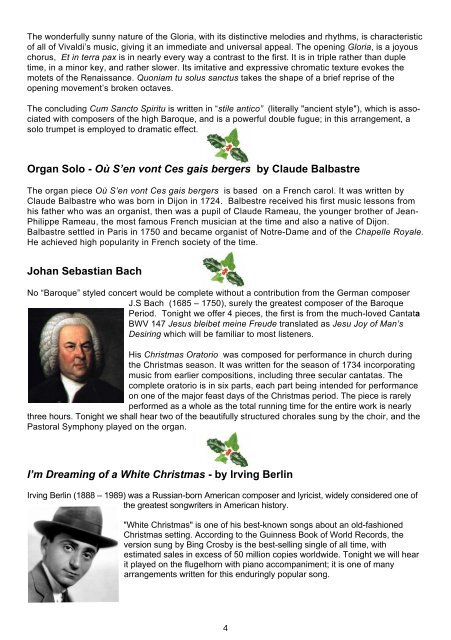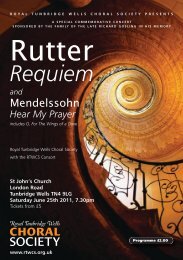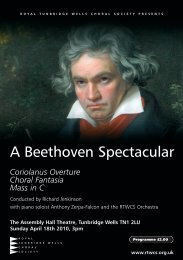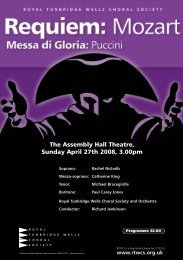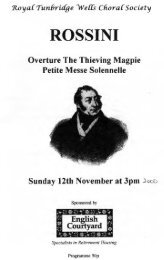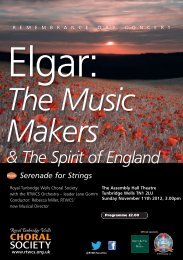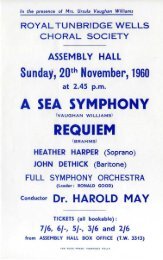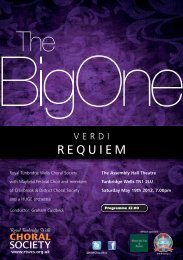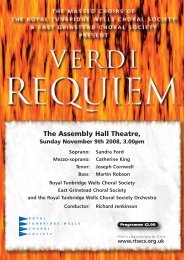Programme - Royal Tunbridge Wells Choral Society
Programme - Royal Tunbridge Wells Choral Society
Programme - Royal Tunbridge Wells Choral Society
You also want an ePaper? Increase the reach of your titles
YUMPU automatically turns print PDFs into web optimized ePapers that Google loves.
The wonderfully sunny nature of the Gloria, with its distinctive melodies and rhythms, is characteristic<br />
of all of Vivaldi’s music, giving it an immediate and universal appeal. The opening Gloria, is a joyous<br />
chorus, Et in terra pax is in nearly every way a contrast to the first. It is in triple rather than duple<br />
time, in a minor key, and rather slower. Its imitative and expressive chromatic texture evokes the<br />
motets of the Renaissance. Quoniam tu solus sanctus takes the shape of a brief reprise of the<br />
opening movement’s broken octaves.<br />
The concluding Cum Sancto Spiritu is written in “stile antico” (literally "ancient style"), which is associated<br />
with composers of the high Baroque, and is a powerful double fugue; in this arrangement, a<br />
solo trumpet is employed to dramatic effect.<br />
Organ Solo - Où S’en vont Ces gais bergers by Claude Balbastre<br />
The organ piece Où S’en vont Ces gais bergers is based on a French carol. It was written by<br />
Claude Balbastre who was born in Dijon in 1724. Balbestre received his first music lessons from<br />
his father who was an organist, then was a pupil of Claude Rameau, the younger brother of Jean-<br />
Philippe Rameau, the most famous French musician at the time and also a native of Dijon.<br />
Balbastre settled in Paris in 1750 and became organist of Notre-Dame and of the Chapelle <strong>Royal</strong>e.<br />
He achieved high popularity in French society of the time.<br />
Johan Sebastian Bach<br />
No “Baroque” styled concert would be complete without a contribution from the German composer<br />
J.S Bach (1685 – 1750), surely the greatest composer of the Baroque<br />
Period. Tonight we offer 4 pieces, the first is from the much-loved Cantata<br />
BWV 147 Jesus bleibet meine Freude translated as Jesu Joy of Man’s<br />
Desiring which will be familiar to most listeners.<br />
His Christmas Oratorio was composed for performance in church during<br />
the Christmas season. It was written for the season of 1734 incorporating<br />
music from earlier compositions, including three secular cantatas. The<br />
complete oratorio is in six parts, each part being intended for performance<br />
on one of the major feast days of the Christmas period. The piece is rarely<br />
performed as a whole as the total running time for the entire work is nearly<br />
three hours. Tonight we shall hear two of the beautifully structured chorales sung by the choir, and the<br />
Pastoral Symphony played on the organ.<br />
I’m Dreaming of a White Christmas - by Irving Berlin<br />
Irving Berlin (1888 – 1989) was a Russian-born American composer and lyricist, widely considered one of<br />
the greatest songwriters in American history.<br />
"White Christmas" is one of his best-known songs about an old-fashioned<br />
Christmas setting. According to the Guinness Book of World Records, the<br />
version sung by Bing Crosby is the best-selling single of all time, with<br />
estimated sales in excess of 50 million copies worldwide. Tonight we will hear<br />
it played on the flugelhorn with piano accompaniment; it is one of many<br />
arrangements written for this enduringly popular song.<br />
4


